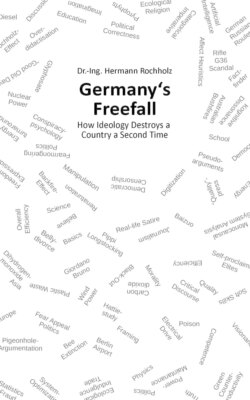Читать книгу Germany's Freefall - Hermann Dr. Rochholz - Страница 25
The “Poison” Glyphosate
ОглавлениеThe German press reports that Monsanto was convicted of using glyphosate in America. That’s incorrect: Monsanto was convicted because the company failed to warn the American public in time about the dangers of “Roundup”.
Roundup contains glyphosate as the herbicidal active ingredient. According to Wikipedia, the lethal dose in rats is up to > 5 g per kilogram body weight.13 An 80 kg (176 lb) man would have to consume 400 g (almost 1 lb) to kill himself. In order for glyphosate to be better absorbed by the plant, it needs a wetting agent. The wetting agent, tallowamine, which is only found in the original, American Roundup, has a lethal dose of about 0.9 g per kilogram of body weight. It’s thus about six times more toxic than glyphosate itself.
It’s obvious that excessive use doesn’t make sense because the weeds will become resistant as well, like penicillin. Since glyphosate has a slight antibiotic effect, any excessive use will destroy soil life as well. But this is probably the case with any fertilizer. Glyphosate is an alternative to plowing. This, in turn, is not optimal for soil life either. No system is without its disadvantages.
The German Railway uses tons of glyphosate to keep its tracks free of weeds. It’s the last approved highly effective herbicide. But a problem crops up even here: Applying glyphosate to sealed surfaces isn’t allowed. For example, it’s prohibited to apply glyphosate to paved cycling paths, which develop slits through which a lot of weeds can grow, especially on street corners, which become hazardous when it rains. This increases the risk of falls for cyclists who are on the road in an eco-friendly manner. In track beds, however, glyphosate is only sprayed on the stones. The ban on applying glyphosate to sealed surfaces doesn’t apply here.
The opponents of glyphosate don’t ask what to use instead when it’s prohibited. Since about 2010, when the Monsanto patents expired, it had “become” a poison. In mid-2017, it was discovered that the Deutsche Bahn is its biggest single customer in Germany. On South Tyrolean cycle paths, the agent is used to suppress Mexican grass that destroys the asphalt surface. The choice here is between using glyphosate and re-asphalting the paths every fifteen or eight years – without glyphosate. German vacationers can be seen taking pictures of the apple orchards there. Often, no green stems can be found under these trees. It’s all sprayed away with glyphosate.
Glyphosate hasn’t killed a single person yet in Germany; the risk of cancer is theorized here without one single piece of evidence, although many other substances are considered “probably carcinogenic” as well, and hundreds of people had died from the insecticide E605 in the past.
